|
The French Musketeers and their conquest of the Davis Cup
|
| This
is one of the first and certainly one of the most heroic stories in the
history of the game of tennis. Toto Brugnon, one of the famous four musketeers,
relates the epic tale in his book on his memories from the game with great
emotion……. It is not only because I am French that I am touched by this
story. It is because there is something so very special and unique about
the collective achievements of this group of four great champions who were
to become known as the Musketeers. Each of us, in our own way, all showed
a strong personality and force of character whilst playing with consistently
high levels of skill and dexterity on a cavalcade of victories across the
world and spanning more than ten years. It is difficult to put into words
the spirit with which we managed to achieve such dominance in singles,
doubles and team events. Indeed, such was our strength that great homage
must be paid to our only real rival and adversary, the great Bill Tilden.
Bill never ceased in his efforts to gain revenge and to topple us from
the crown until he’d passed the grand old age of 37. This story, perhaps
more than any other, forges the myth of what is now known as the Legend
of the Grand Slam.
The battle for the Davis Cup was taken up in 1919 after a five year interval during the First World War. The Americans abstained at this first outing since, sportingly, they recognised that they had not seen the same destruction during the war as the other nations. The Australians however were not distracted from picking up from their successes in the pre-war years under Norman Brookes. For the French, this was a turning point. For the very first time they saw success against the Belgians thanks to Decugis and Laurentz. They also fought bravely against the English, losing only two to three. Gobert won in the singles and Gobert-Laurent beat the now aging Roper Barrett and O.Turnbull in the doubles. In 1920, the Americans rejoined the fray. Tilden and Johnston successively crushed the French, the English and then also the Australians, even though the Australians had brought the great Norman Brookes back for the singles games.
This set the stage for the memorable tournament of 1921. The very success of the tournament and its internationalisation was to result in some set backs in the early stages this year. Twelve nations subscribed and the organisation was to prove difficult. Amongst the newcomers were Japan, the Philippines, Argentina, India, Czechoslovakia and Denmark. Unfortunately Argentina and the Philippines had to forfeit before even starting since at the last minute they couldn’t get a team together. The Belgians beat the Czechs but could not then finance the cost of travelling to America for the next round! The English beat the Spanish and set out for America where they were to meet the Australians who had already knocked out Canada and Denmark. Even deprived of their best two players, Brookes and Peterson, the Australians beat England 5:0. As for the French, the Hindus beat them in the first round. With Gobert (French Champion 1911 and 1920) absent due to illness, Samazieuhi and Brugnon lost 2:3. Samazieuhi was 32 years old and Brugnon 26. Brugnon was the first of the musketeers to take the stage. The defeat was very disappointing for the French but was certainly not to spell the end of their aspirations in future years. |
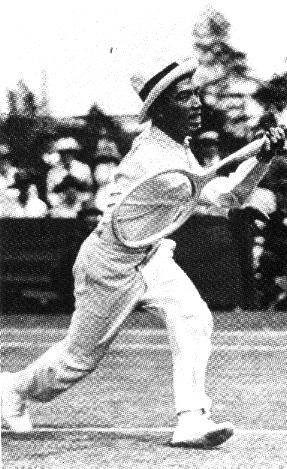
Shimidzu at Wimbledon, 1920 |
The big surprise of the tournament was the Japanese. They firstly knocked out the Hindus before proceeding to play Australia in the last round. The Nipponese Shimidzu and Kumagae might have been small in stature compared to their opponents but they played the games of their lives to successfully eliminate the second favourites and win through to play the current championship holders America. The Americans Tilden and Johnston were to stamp their authority with relative ease but Shimidzu was still to excel. He won the first two sets of his singles match against Tilden, narrowly lost the third 7:5 but then unfortunately collapsed against the stronger opponent. Schimidzu wasn’t in fact a total unknown. He’d been finalist of the “all comers” at Wimbledon the preceding year, again against Tilden, where although beaten in three straight sets, he had at one point or another lead in each of the sets. He had a remarkably distinctive style not unlike that of a ping-pong player. No real service or volley play but incredible control of the racket head, impeccable placement, a second sense as to where he had to play the ball and strong resistance under adversity. He would consistently either return the ball to the feet of his adversary or place an overhead lob to the nearest millimetre. The photograph below shows Shimidzu, sporting a tourist’s hat. It is difficult to imagine that he was a Wimbledon finalist of 1922! |
| 1922 : In 1922 fourteen nations enlisted for the Davis Cup. This time France beat Denmark in the first round thanks to two new musketeers Jean Borotra and Henri Cochet signing up for the occasion. Henri was 21 years old and was newly crowned both French and World Champion on clay. Jean, at 24, was playing only his third year of tennis but benefited from a strong physique and a developed feel for the ball from playing the Basque sport of Pelota. He was already World Doubles Champion on clay with Cochet. Both players therefore had the will to win. This was demonstrated in their doubles game against Tegner and Worm where they tenaciously held on to win 3-6, 6-2, 2-6, 10-8, 6-2. It was left to Cochet and Gobert to undertake the first trip to America where they fought bravely against the Australians Patterson and O’Hara Wood. Cochet beat O’Hara Wood but Gobert lost a very close match over five sets to Patterson. In the doubles the French pair also pushed the famous Australians to five sets, losing the fifth 8-10. This was therefore the first honorable campaign fought by the French in the Davis Cup. It was to bode well for the future. |
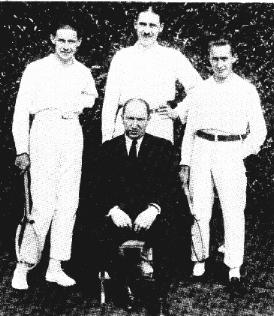
Against Danmark, 1922: Borotra, Gobert, Cochet and Allan Muhr (Cap.) |
| 1924
: saw seventeen entrant countries with the Chinese fielding a team for
the first time. They managed to take a total of fifteen games off the Australians!
In Europe, nobody could challenge the supremacy of the French. They beat
Ireland, India, England and then Czechoslovakia in the final. The musketeers,
without Cochet who was held back in Europe for private professional activities,
again set out for America to play Australia in the inter-zone knock-out
round. This time they lost 2-3 to Patterson- O’Hara Wood in a closely fought
encounter. Lacoste had made significant progress, taking both of his singles
matches. In the Challenge Round, the Americans Tilden and Richards (Johnston
was still not recovered from an illness) won all of their singles matches
and Tilden-Johnston the doubles to give an emphatic 5:0 victory over the
Australians.
It was in 1924 that a Frenchman won a Grand Slam Tournament for the first time with Jean Borotra beating another Frenchman Rene Lacoste in the final at Wimbledon. This was to be one in a long series of victories for the four French musketeers that lasted over six years to 1930. |
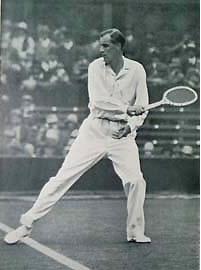
Tilden at the height of his supremacy |
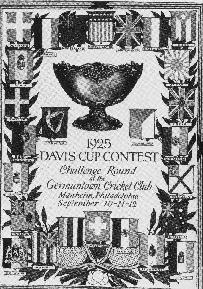
Poster for the Challenge Round of 1925. |
1925 : and a record twenty-five countries sign up for the Davis Cup. The French again win through easily in the European zone beating Hungary, Italy, England and Holland in the final. Only Barotra and Lacoste make the trip to America. This time they at last manage to beat the Australians in the final knock-out round. Barotra was in superlative form and practically won the contest single-handedly. He won his first singles match on day one against Anderson and then with a below par Lacoste won the doubles on day two. On the third day, his singles victory over Patterson gave the French an unassailable 3:1 lead and entry for the first time into the Challenge Round against the awe inspiring Americans. Williams –Richards were simply too strong for Borotra-Lacoste, even though the Frenchmen had only recently been crowned champions at Wimbledon. The final result was 5:0!! Even so, the great Tilden was starting to being caught up by the younger Lacoste who took him to five sets and even had a match point against him in the third; 3-6, 10-12, 8-6, 7-5 and 6-2…oufff!! |
| 1926 : and again, like recent years, the French dominated the European play offs: Denmark, Czechoslovakia, Sweden and then England. This time and for the first time the four musketeers left for America together since Cochet was able to free himself of other commitments. With the Australians not competing this year, they met the Japanese in the final knock-out round. Arriving late with no time for preparation, they were caught napping by a strong Japanese team. The excellent Harada beat both Lacoste and Cochet in the singles. Tarawa also led two sets to zero and five games all in the third against Cochet before the situation was retrieved. The French finally won 3:2 but the error of arriving just before the games were to commence would not be repeated. The challenge round was somewhat of a formality with the Americans winning 4:1. Williams-Richards beat Borotra in the doubles but Lacoste had the pleasure of beating the great Bill Tilden in the last single. This was the first time that Tilden had lost a single match since 1919! Lacoste was only 22 years old... | Harada, who manged to beat both Lacoste and Cochet in 1926. |
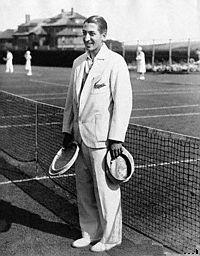
Lacoste, USA, 1926. |
French dreams of taking revenge over the Americans came sooner than expected. One week later in the American Championships at Forest Hills, the four Frenchmen Lacoste, Cochet, Borotra and Brugnon lined up against the four Americans Williams, Tilden, Johnston and Richards in the quarter-finals! To everybody’s surprise only Richards escaped from disaster. Tilden was beaten by Cochet 6-8 in the fifth set having had 2 match points, again his first defeat at Forest Hills since 1919. Borotra beat Johnston, also in five sets, Johnston only having ever lost to Tilden before! Of the three Frenchmen to go through, it was Lacoste who had the easiest passage against Williams. Meeting Cochet in the semi-final he at first went two sets down but then, largely due to the fatigue of his comarade, he finally won through 3:2. He easily beat Borotra in the final 6-4, 6-0, 6-4. |
| This was the first victory
of a Frenchman at Forest Hills and the first foreigner to win here since
Laurie Doherty in 1903. Lacoste was the first person however to recognise
that his victory was for the most part due to the support and comradeship
of the French team as a whole, all of whom had worked so hard together.
1926 turned out to be a feast of victories for the musketeers. They won between them each and every Grand Slam championship. Cochet in Paris, Borotra at Wimbledon and lastly Lacoste in America. They were all three jointly classified world number one together, finally displacing Bill Tilden. The Davis Cup was at last within their reach. |
Épisode précédent
: 1924, The Double Olympic Champion
Vincent Richards
Épisode suivant : 1925-27
: The first international french championship